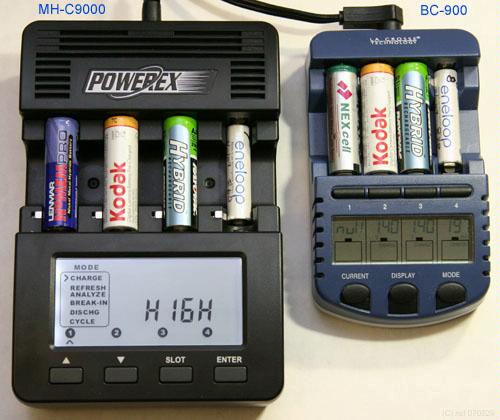AAA or AA Battery Charger
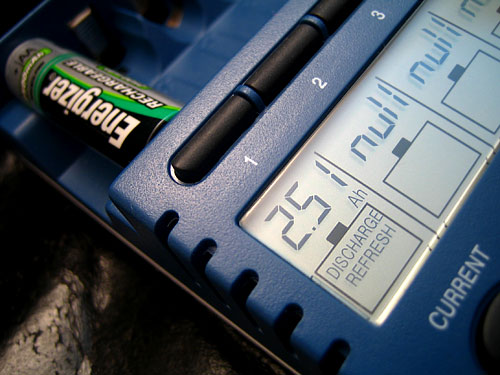
Many of us, buying a Mini-Z radio-controlled car , try to buy a charger that could charge the batteries in the remote control and in the model itself as quickly as possible. Currently, a lot of companies produce chargers that can work with rechargeable batteries of size AA and AAA, but most of these devices are not always suitable for those who begin to participate in competitions. The first thing that athletes need is the speed of battery charging. The second - proper battery maintenance, as a rule, saves a few tenths of a second on the track, and this is sometimes very critical.
All of the above is true for those who are professionally engaged in photography.
Criteria for choosing the right charger:
- power supply 220V
- work with no less than 4 batteries of standard size AA or AAA
- the ability to charge and discharge each battery independently of the others (charge-by-charge and discharge)
- the ability to select a mode for each battery individually (charge; discharge; discharge-charge; discharge-charge several times in a row - cycling; battery recovery mode, etc.)
- the ability to manually set the charging and discharging current
- charging current for each battery - from 800mA
- visual indication of operating modes and status of each battery
- the presence of a temperature sensor (power off when a certain temperature is exceeded)
- the presence of a fan for cooling (preferably)
So, I would like to talk about two chargers in this review that have proven themselves around the world for several years. It is worth noting that it is these two chargers that you can most often meet with winners of various Mini-Z championships around the world and professional photographers.
1. Alpha Power Battery Charger BC-900 from La Crosse Technology
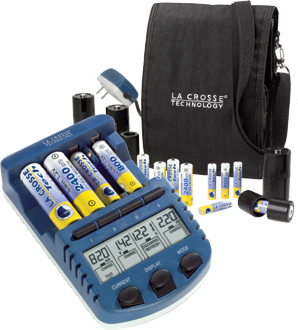
Features Alpha Power Battery Charger BC-900 :
- Batteries: AA, AAA, C, D
- charge of each battery with current up to 1800 mA with a choice
- side discharge
- cycling
- recovery mode for old batteries
- indication of modes
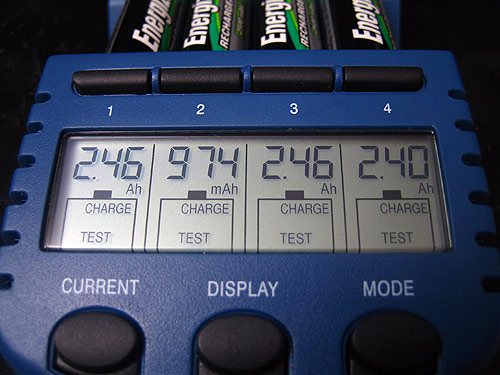
Feedback (not mine):
If a two-color light bulb is not enough for you and you are sure that you know better than any Chinese plastic box what and how you want to charge, and you also want to see what happens - the bc-900 is for you.
Instructions and specifications: all parameters are normally painted, incl. maximum battery capacity (3 A * h). It is quite convenient to use, after reading the instructions there were no questions and no problems with the choice of modes. The
charger is almost perfect - it does not try to think for the user, leaving him the right to decide how to charge the battery and what to do with it.
Shows the battery voltage, mode (charge / discharge / injected or removed capacity / time since the beginning of the cycle).
You can measure the actual battery capacity in test mode - first the battery is charged, then discharged, then the charge again - and the capacitance taken during the discharge is shown on the display.
I liked the refresh mode - consecutive charging and discharging cycles until reaching maximum capacity. Only for a long time, but if you don’t rush anywhere, why not take a thread with an idle charger?
By the way, this charger returned the Varta Photo 1900 battery pack to operation - and my old Ansmann digispeed 4 charger simply refused to charge them.
As for the design and configuration - I liked everything, I was pleased with the adapters for emulating batteries of type C and D. Well, the ftw carrying bag The pulse adapter for 100-240V is perceived as a must have for such a device.
I liked the La Crosse BC-900 so much that it would be tiring to paint all the pros, it’s easier to note the flaws
So, the cons (fortunately, not spoiling the battery charger experience, but just distinguishing it from an absolute and unattainable ideal
- no forced cooling. Temperature protection is good, but I would prefer forced cooling when you need to charge batteries quickly. I do not like to charge batteries with a current of more than 700mA - they are heated quite strongly.
- silly (IMHO) restriction - when the first battery was inserted and its charging current was indicated, for all others charged simultaneously with it, the current is limited from above by the charging current set for the first element.
- maximum discharge current is “locked” as half of the charger. Those. if we want to discharge the battery with a current of 500mA, then the charging current will be 1A. It seems logical to me when the discharge current is greater than the charge current. I would prefer, say, to measure the battery capacity for the camera at the maximum discharge current, and charge it with the minimum charging current.
Summary: The best portable charger. Yes, yes, and without any “possible”
PS Let's talk about reliability after 3-5 years of operation - how can I give an assessment earlier? I can’t imagine, except to use several dozen devices at the same time.
PPS Since to send a rating you need to set a reliability rating, I put “5 ″.
2) MAHA MH-C9000 WizardOne Charger-Analyzer Charger from Maha Energy Corporation
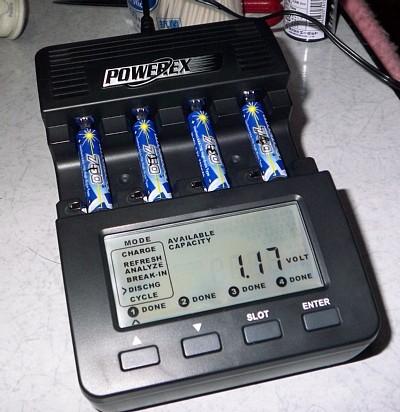
His characteristics are wonderful ... screen backlight ... black-and-white management ... all things!
- Charging Current: Programmable from 0.2A to 2.0A in increments of 0.1A
- Topoff Charging Current: 100mA
- Maintenance Charging Current: 10mA
- Discharge Termination: Voltage 1.00V
- Discharge Current: Programmable from 0.1A to 1.0A in increments of 0.1A
- Capacity Storage Memory: 12 (Cycle mode only)
- Supported Capacity: 100 to 20,000mAh.
- Charger Input Power: 12V 2.0A
- Adapter Input: 100-240V 50 / 60Hz
I decided to order it at the end of last season. And then I stumbled upon the following review and changed my mind, I’ll take myself another new LaCrosse :
Well, I tested this new charger from Machi during the holidays .
If integrated, then it is worse than the Lacrosse, although there are some advantages that are absent in the BC-900.
In order not to be unfounded I give a list of advantages and disadvantages.
Although there is no satisfaction from him at heart, and you obviously cannot satisfy your “techno-phishism” with him, the
Minuses of Maha MH-C9000:
1. When charging an AAA 800mAh battery with a current of 700mA, the MH-C9000 overheated it so much that the battery began to boil, and an electrolyte flowed out of it directly into the charger. A detailed investigation of this situation showed immediately the presence of one manufacturing defect, one miscalculation in the design and not fully debugged algorithm for determining the end of charge from the voltage drop. A manufacturing defect is the absence of thermal paste on all 4 thermal diodes. As a result of this, there was no contact of the thermal diode with external metal thermal contacts of the charger. The miscalculation of the design consists in very narrow metal thermal contacts of the charger, which are also located so that when AAA batteries are inserted, the thermal contacts only partially touch the batteries. BC-900 has a more correct arrangement of metal thermal contacts, moreover, they are wider, have better contact with the battery case of any form factor, and AA and AAA. The sensitivity of the MH-C9000 charger to the voltage drop at the end of the charge was also, as it turned out, unsatisfactory, since it allowed overcharging of the battery when the thermal monitoring channel was not working (due to lack of thermal paste). (According to the manufacturer, the MH-C9000 has “Negative delta V, peak voltage, dT / dt (temperature rise) and max temperature protection”).
2. Despite the restored contact of the thermal diode with the battery, I was not able to simulate the situation of a temporary cessation of charge during overheating, followed by the resumption of charge when the battery cools, even at a charge current of 2000mA. When the temperature increased to 56 degrees, charging simply stopped, the message “Done” appeared and the charge did not turn on again. The stored energy in the battery was below the actual battery capacity, measured in the "Refresh & Analyze" mode. BC-900 in such a situation behaves correctly and resumes charge when cooling the "experimental".
3. The backlight does not turn off. The reliability of this solution immediately raised doubts, which, unfortunately, was confirmed in practice - after a day of testing, the backlight simply died. At night, the "night light" in the form of a constantly lit backlight of the charger looks defiant and unjustifiably necessary. Without backlight, the charger looks more logical, if only something else had not fallen off during operation.
4. The board manually soldered 4 elements, presumably a diode, clearly after detecting operational errors and launching the printed circuit board into serial production. This fact indicates the “dampness” of the charger and not the flexibility of MAHA ENERGY CORP.
5. Less reliable AAA fastening of the batteries - the spring contact tab is located far from the center of the battery and the latter can easily pop out during inaccurate installation or shaking.
6. The device is not as high-tech as La Crosse Technology BC-900 - standard components with a not so high degree of integration are used. There are no specialized custom unpacked chips, such as in La Crosse Technology BC-900.
7. It is doubtful whether the Refresh & Analyze mode requires two hours of rest (Rest). Theoretically, of course, in order for the chemical processes in the battery to complete and the temperature to decrease, the wait is probably useful, but spending two additional hours in the Refresh & Analyze mode to the fully corresponding Test BC-900 mode is hardly advisable.
8. I would not want to argue with the IEC standards, however, a 16-hour charge with a current of 0.1C by timer, a wait of 1 hour, a discharge with a current of 0.2C, a wait of one more hour and the final 16-hour charge with a current of 0.1C in the “Break- In "also do not consider it advanced, but the ability to use the anachronistic method of charging in a modern smart device.
9. I consider the “Cycle” mode a miserable likeness of the “Refresh” mode in the BC-900. La Crosse Technology BC-900 will determine when to stop the charge-discharge process due to the absence of an increase in the capacity given during discharge. The MH-C9000 must manually indicate the number of charge-discharge cycles. In addition, the MH-C9000 has a limited number of cycles of 12, and the BC-900 can carry out 20 charge-discharge cycles if necessary.
10. In the MH-C9000, it is not possible to change the battery mode without re-installing the battery in the seat slot. BC-900 allows you to change the operating mode without changing the charge-discharge currents.
11. As the built-in tester shows, the MH-C9000 with less accuracy than the BC-900 can withstand user-defined charge / discharge currents.
12. If the mains voltage fails and the MH-C9000 is turned back on when the power supply resumes, the charge mode with current 1A is automatically initiated. This charge current is not desirable for modern AAA form factor batteries. This feature, together with the design features mentioned above, does not allow us to recommend this charger for charging AAA batteries.
13. The MH-C9000 does not show the open circuit voltage of the battery at the time it was installed in the seat slot. Only after starting a certain operating mode. The function of displaying the open circuit voltage of the battery at the time of its installation in the landing socket would allow determining the internal resistance of the battery at constant current - one of the characteristics of the “quality” of the battery, without the use of an additional voltmeter.
14. Different chargers represent a different load for charged batteries when disconnected from their power supplies or 220v network. In one case, charged batteries can even be stored inserted in the charger, in the other, remove them as quickly as possible in order to reduce discharge during storage. In this regard, the MH-C9000 is clearly worse than the BC-900 (the MH-C9000 has a large leakage current) and is no different:
Varta Type 57039 - 0 μA;
La Crosse Technology BC-900 - 25 μA (11 μA at the beginning of operation; 1.9 mA with an inserted power supply unit);
GP PowerBank Smart2 GPPB14 - 25-90 μA (depending on the channel and does not depend on whether the AC adapter is inserted into the charger or not);
Olympus BU-300E - 75uA;
Acme Power RC-6 340mkA (480mkA with the inserted network power supply);
Maha MH-C9000 - 0.8mA (1.1mA with an inserted power supply unit);
Ansmann Energy 4 - 13mA.
15. The indication of the parameters is very inconvenient. It jumps not only cyclically in the parameters of one selected channel, but in all parameters of all active channels. It seems uncomfortable to me.
16. The modulated high-frequency whistle of pulse converters, which are located not only in the network power supply, but also in the charger itself, is very annoying. The whistle is very strong, you just don’t feel like sleeping nearby or working at the table on which the MH-C9000 is located - you begin to get annoyed and nervous.
17. The package does not include batteries, bag and C / D adapters of form factors, despite the fact that the price of the MH-C9000 charger is higher than the BC-900. In the Powerex branded bag ordered for an additional fee from the set of optional accessories for the MH-C9000, the charger itself, not to mention the AC adapter, does not fit.
18. Compared to the BC-900, the MH-C9000 is simply huge.
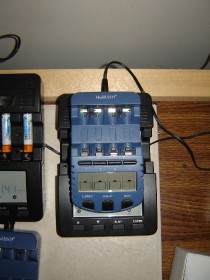
Advantages of the Maha MH-C9000:
1. When the battery is discharged below 0.9V, the MH-C9000, unlike the BC-900, perfectly recognizes the inserted battery and starts the charging process.
2. The MH-C9000 has a larger range and a smaller pitch of charge-discharge currents. In addition, the programmed charge and discharge currents of the batteries already installed in the charger do not have a limiting effect on the value of the charge and discharge currents of the batteries installed later.
3. In order to test the batteries (but not to operate the batteries in order to free them from the memory effect), the MH-C9000 has a more “correct” “Discharge” mode - after discharge, the charge is not carried out, and the capacity readings are stored on the indicator. This feature, as well as the lack of checking the internal resistance of the element in the “Discharge” mode, allows measuring capacitance even for primary elements of form factors AA and AAA with voltages up to 1.5V, including the recently developed Energizer one and a half-volt lithium (Li / FeS2) cells.
